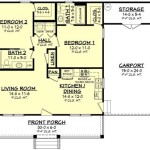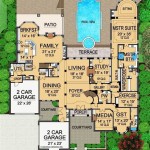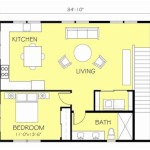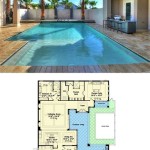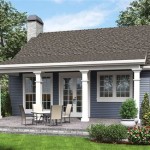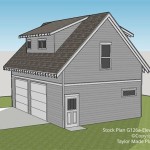Floor Plan With Inlaw Suite: A Comprehensive Guide
The housing landscape is constantly evolving, and one of the trends gaining significant traction is the incorporation of in-law suites into residential floor plans. An in-law suite, also sometimes called an accessory dwelling unit (ADU), granny flat, or guest suite, provides a self-contained living space within or attached to a main residence. This arrangement offers numerous benefits, from accommodating aging parents or returning adult children to generating rental income. Understanding the nuances of floor plans with in-law suites is crucial for homeowners considering this addition.
The design and functionality of an in-law suite are paramount. It's not simply a spare bedroom and bathroom; it's a miniature version of a house, requiring careful planning to ensure comfort, privacy, and accessibility. This article will delve into the key considerations when planning a floor plan with an in-law suite, exploring design options, legal and regulatory aspects, and the potential benefits and drawbacks of this increasingly popular housing solution.
Key Considerations in In-Law Suite Floor Plans
Designing an in-law suite involves more than just adding space to a house. Several critical factors need to be considered to create a functional, comfortable, and legally compliant living area. These considerations range from accessibility and privacy to code compliance and independent living amenities.
Accessibility: The accessibility of the in-law suite is often a primary concern, especially if the suite is intended for elderly or disabled individuals. Features like zero-step entrances, wider doorways and hallways, grab bars in bathrooms, and roll-under sinks are essential. Furthermore, consider the location of the suite relative to the main house. A suite on the ground floor or with elevator access is preferable for those with mobility limitations. Even if the occupants are currently able-bodied, planning for future needs is a prudent strategy.
Privacy: One of the core objectives of an in-law suite is to provide independent living. This requires careful consideration of privacy. A separate entrance is often a necessity, allowing occupants to come and go without disturbing the main household. Soundproofing measures, such as insulated walls and floors, are also crucial to minimize noise transfer between the suite and the main residence. Strategically placing windows and doors can also enhance privacy by limiting views from one living space to the other. Creating a visual barrier with landscaping can further enhance the feeling of separateness.
Independent Living Amenities: An in-law suite should be equipped with all the essential amenities for independent living. This includes a fully functional kitchen with a sink, stovetop, refrigerator, and microwave. A private bathroom with a toilet, sink, and shower or bathtub is also essential. Laundry facilities are another important consideration, whether a separate washer and dryer within the suite or shared access to laundry facilities in the main house. Ample storage space is also necessary, including closets, cabinets, and potentially a small storage area for personal belongings. The inclusion of these amenities allows the occupants to live self-sufficiently, promoting autonomy and comfort.
Design Options for In-Law Suites
The design of an in-law suite can vary significantly depending on the homeowner's needs, budget, and the existing structure of the house. There is no one-size-fits-all solution; the ideal design will be tailored to the specific circumstances of the property and the occupants. Several common design options exist, each with its own advantages and disadvantages.
Attached Suite: An attached in-law suite is typically built as an addition to the existing house, sharing at least one wall with the main residence. This option can be relatively cost-effective, as it often utilizes existing utilities and foundation. An attached suite provides easy access to the main house, which can be beneficial for older individuals who may need assistance from family members. However, it can also compromise privacy if not designed carefully. Separate entrances and soundproofing measures are crucial in this design. The attached suite can be seamlessly integrated into the existing architectural style of the house, maintaining a cohesive exterior appearance.
Detached Suite: A detached in-law suite, also known as a backyard cottage or a detached ADU, is a separate structure located on the same property as the main house. This option offers the greatest level of privacy, as the suite is completely independent from the main residence. It also allows for more flexibility in design, as the suite can be built to any desired size and style. However, a detached suite is typically more expensive than an attached suite, as it requires its own foundation, utilities, and building permits. Zoning regulations may also restrict the size and location of detached ADUs. Despite the potential challenges, a detached in-law suite can be an excellent option for homeowners who prioritize privacy and independence.
Basement Suite: Converting a basement into an in-law suite can be a cost-effective option if the basement is already finished or partially finished. Basements tend to be naturally cooler and quieter, which can be appealing to some occupants. However, basement suites can also have limitations, such as limited natural light and potential moisture problems. Egress windows are essential for safety, providing an escape route in case of fire. Waterproofing and proper ventilation are also crucial to prevent mold and mildew growth. Furthermore, basement suites may require significant renovations to meet building codes and accessibility standards. Careful planning and adherence to building regulations are essential for a successful basement in-law suite conversion.
Legal and Regulatory Considerations
Before embarking on the construction of an in-law suite, it's crucial to understand the legal and regulatory requirements in the local jurisdiction. Zoning regulations, building codes, and permit requirements can vary significantly from one municipality to another. Failure to comply with these regulations can result in fines, delays, or even the forced removal of the suite.
Zoning Regulations: Zoning regulations dictate how land can be used within a particular area. These regulations may restrict the size, location, and occupancy of in-law suites. Some jurisdictions may prohibit ADUs altogether, while others may have specific requirements for setbacks, parking, and lot coverage. It's essential to consult with the local zoning department to determine the permissible size and location of the suite, as well as any other restrictions that may apply. Understanding these regulations early in the planning process can prevent costly mistakes and delays.
Building Codes: Building codes establish minimum standards for the construction and safety of buildings. These codes cover a wide range of aspects, including structural integrity, fire safety, electrical wiring, plumbing, and ventilation. An in-law suite must comply with all applicable building codes, which may differ from those for single-family dwellings. For example, the suite may require its own separate electrical meter, fire alarm system, and egress windows. It's essential to work with a licensed contractor who is familiar with local building codes and can ensure that the suite is constructed in compliance with all regulations. A thorough inspection process is typically required to verify compliance with building codes.
Permit Requirements: Building permits are required for most construction projects, including the addition of an in-law suite. The permit application process typically involves submitting detailed plans and specifications for the project to the local building department. The plans will be reviewed to ensure compliance with zoning regulations and building codes. Once the plans are approved, a permit will be issued, allowing construction to begin. Inspections will be conducted throughout the construction process to ensure that the work is being done in accordance with the approved plans and building codes. Obtaining the necessary permits is essential to avoid fines and legal issues down the road. It also ensures that the suite is safe and habitable.
Furthermore, landlords must adhere to fair housing laws and regulations when renting out an in-law suite. These laws prohibit discrimination based on race, color, religion, national origin, sex, familial status, and disability. Landlords must also ensure that the suite is safe and habitable, and that they provide equal access to amenities for all tenants. Understanding these requirements is crucial for ensuring compliance and avoiding legal disputes.
In conclusion, planning a floor plan with an in-law suite is a multifaceted endeavor that requires careful consideration of accessibility, privacy, design options, and legal and regulatory requirements. By thoroughly researching and addressing these key aspects, homeowners can create a functional, comfortable, and compliant living space that meets the needs of their family or tenants. Seeking professional guidance from architects, contractors, and legal experts can further ensure a successful and rewarding in-law suite project.
One Story Layout With In Law Apartment Builder

House Plan 65862 Tuscan Style With 2091 Sq Ft 3 Bed 2 Bath 1

In Law Suite Plans Give Mom Space And Keep Yours The House Designers

One Story With In Law Suite Plan 2286

House Plans With In Law Suites Houseplans Blog Com

House Plans With In Law Suites Houseplans Blog Com

Pin Page

Front Side View House Plans With A Separate In Law Suite

Craftsman House Plan With In Law Suite 1443

Designing And Building New Homes With Mother In Law Suites David Weekley


